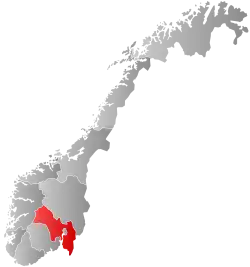Fet
Fet was a municipality in Viken county, Norway. It was part of the Romerike traditional region. The administrative centre of the municipality is the village of Fetsund.
Fet kommune | |
|---|---|
 | |
 Flag  Coat of arms  Viken within Norway | |
 Fet within Viken | |
| Coordinates: 59°52′47″N 11°13′14″E | |
| Country | Norway |
| County | Viken |
| District | Romerike |
| Administrative centre | Fetsund |
| Government | |
| • Mayor (2005) | Lisbet Lofthus Gabrielsen (Ap) |
| Area | |
| • Total | 176 km2 (68 sq mi) |
| • Land | 137 km2 (53 sq mi) |
| • Rank | #347 in Norway |
| Population (2004) | |
| • Total | 9,485 |
| • Rank | #108 in Norway |
| • Density | 69/km2 (180/sq mi) |
| • Change (10 years) | |
| Demonym | Fetsokning[1] |
| Official language | |
| • Norwegian form | Bokmål |
| Time zone | UTC+01:00 (CET) |
| • Summer (DST) | UTC+02:00 (CEST) |
| ISO 3166 code | NO-0227 |
| Website | Official website |
Fet was established as a municipality on 1 January 1838 (see formannskapsdistrikt). The new municipality of Rælingen was separated from Fet on 1 July 1929. The part of Enebakk municipality lying east of lake Øyeren was transferred to Fet in 1962. On 1 January 2020 Fet was merged with Skedsmo and Sørum municipalities to form Lillestrøm municipality.
General information
Name
The name (Old Norse: Fit) was first recorded in 1321 (a Fit). The word fit means 'vigorous meadow'.
Coat-of-arms
The coat-of-arms is from modern times. They were granted on 19 December 1986. The arms show a logging hook, which was used in the area to haul the logs cut in the surrounding forests. The logs were transported over the streams and lakes to the sawmills. The people used long poles with hooks to haul the logs. The colours of the arms are green and silver because the name is derived from an old word describing a field (green) near a lake (silver).[3]
| Ancestry | Number |
|---|---|
| 455 | |
| 167 | |
| 105 | |
| 79 | |
| 73 | |
| 72 | |
| 67 | |
| 67 |
Geography

Fet is located on the eastern side of Lake Øyeren and includes the point at which the River Glomma enters the lake. The inland river delta that has formed is the largest in Europe and reaches the opposite shore of the lake, across its short axis. Until 1985, logs floated down the river were brought onshore here before the river entered its delta, and were then transported onwards by rail. Today, many of Fet's floating buildings have been preserved and converted into a museum and cultural centre.
Notable residents
- Jacob Aall Ottesen (1825–1904), Norwegian American minister, theologian, and church leader.[5]
References
- "Navn på steder og personer: Innbyggjarnamn" (in Norwegian). Språkrådet.
- "Forskrift om målvedtak i kommunar og fylkeskommunar" (in Norwegian). Lovdata.no.
- Norske Kommunevåpen (1990). "Nye kommunevåbener i Norden". Retrieved 2008-12-18.
- "Immigrants and Norwegian-born to immigrant parents, by immigration category, country background and percentages of the population". ssb.no. Archived from the original on 2 July 2015. Retrieved 25 June 2017.
- Jacob Aall Ottesen (Store norske leksikon)
External links
 Media related to Fet at Wikimedia Commons
Media related to Fet at Wikimedia Commons The dictionary definition of Fet at Wiktionary
The dictionary definition of Fet at Wiktionary- Municipal fact sheet from Statistics Norway
 Viken travel guide from Wikivoyage
Viken travel guide from Wikivoyage- Øyeren information centre (INØ) (in Norwegian)

